Pre-A and T-SWISS-T Officine
Panerai - 1997-1998.
� 2005 by Maurits Bollen and Paneristi.com
Web page prepared by Jay Pulli
Introduction.
Nearly everyone
on the forum
is well acquainted with the A-series 44 millimeter Officine Panerai
hand wound
watches. Presented at the SIHH in Geneva in 1998, we all have come to
love
these fine time pieces because of their sheer size, simplicity and the
strong
graphic design features of their -by now- patinaed Tritium dials. And,
it is
not just die-hard Paneristi that have started collecting these watches
in a
serious manner. More and more traditional watch collectors have
recognised the
uniqueness of neo-vintage Officine Panerai.
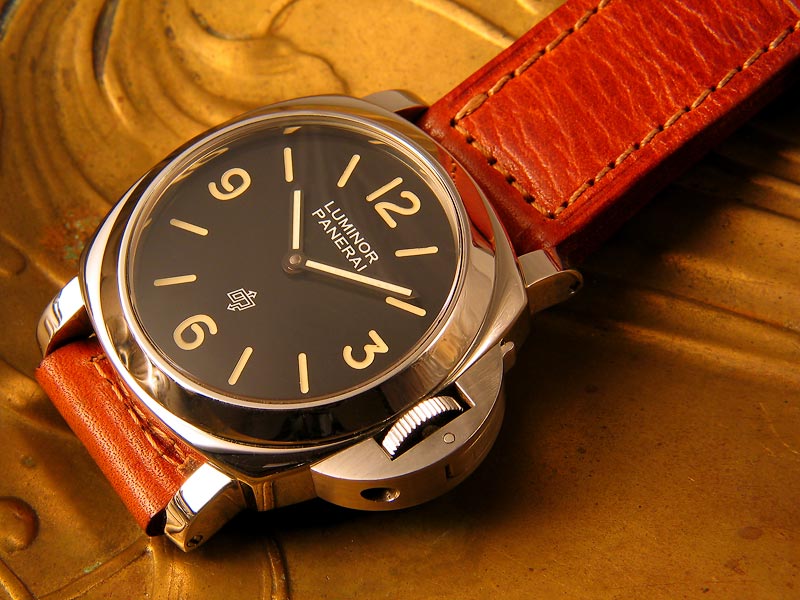
[ picture #01: The absolute
quintessential post-vintage Panerai � a pre-Vendome 5218-201/A Logo
from 1993.
My absolute queen and daily wearer. ]
Genuine vintage
Officine
Panerai watches (built from the 1930's through the 1950's) have reached
a price
level unobtainable for ordinary enthusiasts like you and me.
Pre-Vendome or
Replica Officine Panerai (1992-1997) is steadily going in the same
direction.
Of course, the company that produced these watches does not exist
anymore. No
doubt this, and the rumours surrounding a �yet to be published- book on
vintage, pre-Vendome and all Tritium dialed Richemont watches by a well
known
Italian scribe of Rolex-book fame and high profile watch professional,
has
helped giving the A- and some of the B-series 44 millimeter Officine
Panerai
the hot status the brand currently has obtained in the watch world.
Prices are
going through the roof. Any Tritium dialed Officine Panerai is a watch
to get
now, or forever be sorry!
The Pre-A Series.
Few collectors
realise,
however, that before the A- and B-series PAM's 001 (Luminor Marina),
002
(Luminor), 003 (white dial Luminor Marina), 004 (PVD Luminor Marina),
009 (PVD
Luminor) and 010 (white dial Luminor), Officine Panerai issued three
(some
would say four) small series of watches to test the waters and generate
media
attention before real production was on its way. I believe most of
these
watches were destined to be primarily sold on the Italian, Swiss and
German
markets. Officine Panerai did so in 1997 and 1998. These, largely
unknown,
series are now called "pre-A" series. Simply because they pre-date
the 1998 A-series Luminor Base series of a 1000 pieces, AXXXX/1000 OP
6502 and
1500 Luminor Marinas AXXXX/1500 OP 6502. The latter two are, of course,
the
"real" A-series as we all know them.
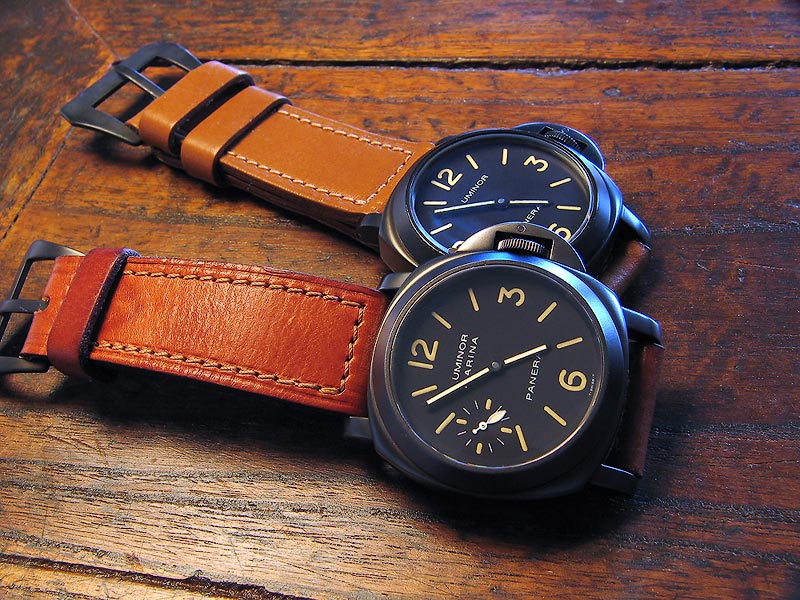
[ picture #02: Two lovely
PVD pre-A's, PAM 004 and PAM 009. ]
On most pre-A
Luminors (or
Bases) and Luminor Marinas you will find pre-Vendome style or T-SWISS-T
dials
(note the hyphens), solid brass dials with a black satin finish and
wider and
deeper tritium indices than the later style T SWISS T dials (no
hyphens). The
old style, bold dial lay-out of these watches is what really sets them
apart
from later models and is THE reason for their collectability.
Dial-wise, it
doesn't matter
whether a pre-A is housed in an OP6500 or OP6502 reference case. From
OP 6500
BB 970001 right through OP 6502 BB 971700 (less 400 Mare Nostrums, of
course,
and less the white dialed Luminors and Luminor Marinas), as a rule, all
pre-A
Luminors and Luminor Marinas came with a pre-Vendome style T-SWISS-T
dial. Only
a few have T SWISS T dials, either when Officine Panerai tried the new
dial
style shortly in early 1998 in the old pre-A series (bad luck), or
because of a
later re-dial when having been serviced (a severe case of bad luck).
Strange things
sometimes
happen at Officine Panerai Service Centers. A fellow Dutchman I know
pretty
well told me with a very, very happy face that a Cartier
employee/friend of his
had helped him getting a Luminova dial in his A-series Power Reserve
because it
no longer lit up in the dark. And yes, he also took great care that the
stupid,
non luminous little arrow hand was replaced. Who needs enemies with
friends
like that?
All pre-Vendome
and
T-SWISS-T indices have exactly the same shape; these sport the
"crooked" numbers that give them their special "fatto a
mano" look. Compared to regular A-series, look for the differences
between
the "6", the "9" and the "2" in "12".
The "6" and the "9" are less open and not at all rounded.
The stem of the "2" does not go up first and then to the right, but
immediately starts-off in a diagonal direction. If asked, I would say
the
numerals to me look "pinched".
Once you have
seen the
difference, you will not forget.
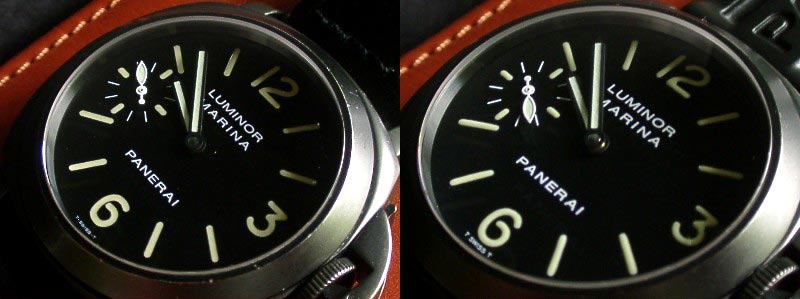
[ picture #03: T-SWISS-T
next to T SWISS T. Picture by Hiro-san. ]
Here, in this
fantastic
picture by William Loi, is a good example of what it is all about. On
the left
you will see a pre-Vendome 5218-202/A PVD Luminor Marina Militare. One
of the
most valuable and sought-after pre-Vendome Officine Panerai watches,
made in a
series of 90 watches in 1993 and a further 50 watches in 1994. On the
right you
will see a pre-A PVD PAM 009 Luminor from 1997/1998. There is no
difference in
the shape of the indices. Compared to the older dials, I dare say that
the
pre-A dial is even more balanced and cut to the bone. Less is more.
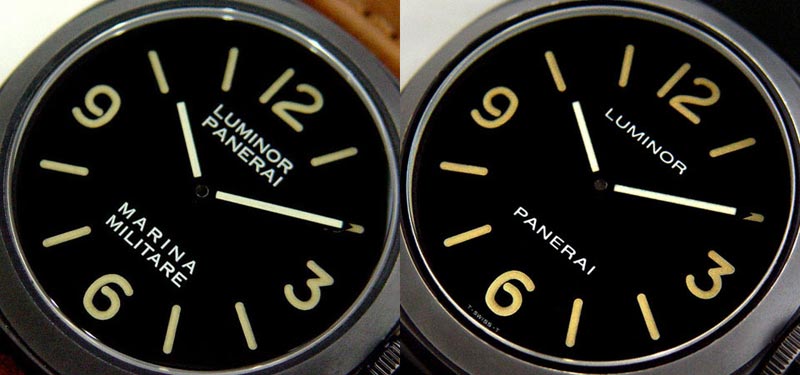
[ picture #04: 5218-202/A
next to pre-A PAM 009 by William Loi. ]
And less costs
less! Of
course there are differences between these watches you cannot see in
this
picture. The dial finish is different (more of that later). The
pre-Vendome
watch comes in a different box and has a larger, brush finished crown
protector. It was supplied with two 24 millimeter non-tapered straps
with the
PVD perl� logo big buckle and a two-screw strap fixing arrangement. The
case
back is different, featuring the logo and the movement is even more
basic than
in Pre-A watches. But my point is: the pre-A PAM 009 can be picked-up
for less
than half the price of the Marina Militare and is probably just as
rare! To
christen it the "Poor Man's Marina Militare" is grossly
underestimating this fine watch, yet superbly sums-up what you get when
buying
into this package. Talking about value for money.
Another fine
example: a
5218-201/A Luminor Logo from 1993 on the left, next to a Pre-A PAM 002
Luminor.
Here the difference in value is less dramatic (though again about fifty
percent). But still, you get almost full pre-Vendome looks for al lot
less
money (can you tell by now I am Dutch?).
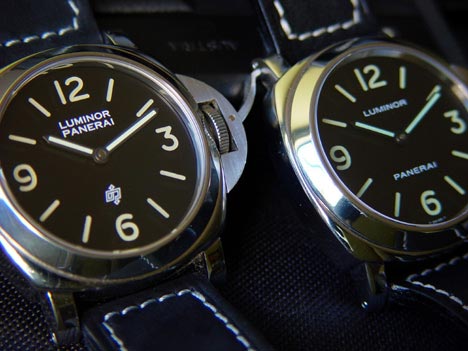
[ picture #05: Logo without
a logo, 5218-201/A next to pre-A PAM 002 by Joel Pirela. ]
I combined two
pictures by
Hiro-san to show the similarities in the dials of a pre-Vendome
2518-203/A PVD
Luminor Marina and a pre-A PVD PAM 004. Again, the pre-A can be found
for less
than half.
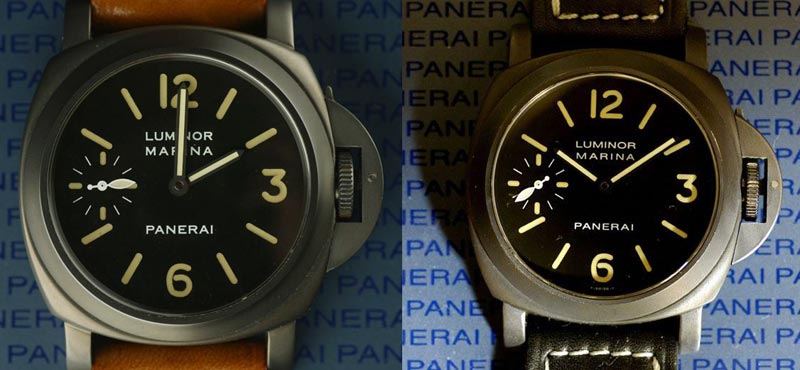
[ picture #06: 5218-203/A
next to pre-A PAM 004 by Hiro-san. ]
The Pre-A OP 6500 Series.
When Officine
Panerai, as a
new Vendome subsidiary and sister brand of Cartier (the Vendome group
was later
acquired by Richemont) re-entered the watch market in 1997, they
took-off with
a small series of Historical-only watches. All were Luminor Marinas and
Luminors. To begin with, a series of together 1000 OP 6500 PAM 001,
002, 003,
004, 009 and 010 was planned. This series of watches started with
serial number
BB 970001. BB probably is a discriminatory letter code that otherwise
has no
meaning to me. 97 is a denominator for the year of birth of the new
Officine Panerai
company, but looses its year-related meaning afterwards, when the
number 98 was
reached. It is now an integral part of the serial number. The remaining
four
digits are a sequential production number.
The oldest
example I have
seen is a 1997 PVD pre-A PAM 009 numbered BB 970007 � 0007/1000, fondly
known
as the Bond Panerai. It is only the seventh Vendome Panerai ever
produced.
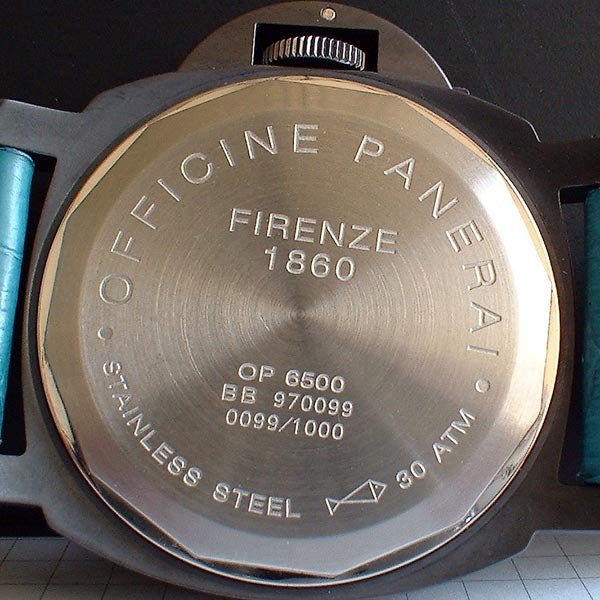
[ picture #07: Example of an
OP 6500 case back. Picture by Vanni Chiozzi. ]
It is fairly
easy to
identify a pre-A watch of the first series. For OP 6500 pre-A's, the
last four
digits of the BB-number or serial number should equal the four digits
of the
millesimation number. The relationship between serial number (BB) and
millesimation number (0XXX/1000) is always consistent and logical. This
last
principle holds true for all pre-A's.
EG: OP 6500 �
BB970001 =
0001/1000 or OP 6500 � BB970499 = 0499/1000.
A Case for the Case.
I am not sure
what the real
difference is between the OP 6500 case reference and the later OP 6502
case
reference. There is a rather cryptic comment by Angelo Bonati, CEO of
Officine
Panerai, dated September 2003: "The Luminor were sold in the Italian
market. Concerning Luminor 400 cases were a part of stock of old OP and
600
were produced by our factory. In fact old Panerai cases show a little
lack." Maybe OP 6500's are those 400 old stock cases, and the 600 OP
6502?
It is possible because the last pre-Vendome watches, 5218-209 and
5218-210 had
one long screw to hold each strap-end. The same configuration as the
pre-A and
regular A-watches. However, more than those 400 cases were used for OP
6500. At
least, that would have been necessary to reach the production number of
500+ OP
6500 items.
In any event, at
the time
when Cartier initiated the purchase of the watch division from the old
Officine
Panerai company, Panerai had scheduled a second run of 500 Luminors and
Luminor
Marinas. These watches were code numbered 5218-209 (150) and 5218-210
(350).
Only twelve Luminors (with polished bridges) and a mere two Luminor
Marinas
were produced. "The completion of the supply was subsequently prevented
by
the sale of the watch division", states Col. Ing. Zei in his 2003 book
"La Panerai di Firenze". According to Yves Odier "Coro, [ � ]
the Florentine company under Pre-Vendome officially only produced a
little
amount of watch-cases 5218-209 & 5218-210 and I believe that they
may have
also produced some watch-cases for "Vendome" in the very early moment
of the take over." Maybe the cases (or the contract) for the 500 never
produced pre-Vendomes eventually found their way to the customer in an
OP 6500
guise? If that holds true, maybe the same principle is valid for the
T-SWISS-T
dials?
The agreement
between the
old Officine Panerai SpA. and Cartier led, among others, to a transfer
of all
things related to the watch division; workshop drawings, quality
control
documents, trade marks (among which the right to use the name "Officine
Panerai" from then on, the old company was renamed Panerai Systemi
SpA.)
and patents and of the stock of watches. It was also agreed that the
old
Panerai was to advise on the design of new watch models for about two
years. If
you ever have the chance to visit Dirk in his beautiful home near
Antwerp, in
between the classy wines he pours, ask him to show you a 1995 business
plan for
the Slytech brand. Although this plan came to no avail because of the
dubious
nature of its initiator, there is a lot in there that resembles the
introduction of the new Officine Panerai in 1997. Submersibles, GMT's,
a PAM
021-ish watch, it is all there.
As said, the
straps were
fixed to pre-A cases with one long screw, like it is done in today's
Panerai
watches. All strap screws and tubes were made of stainless steel. For
PVD
pre-A's, however, the screw-heads were blackened, not PVD treated. The
rest of
each screw was left untreated. The strap tubes appear to have the same
blackened finish. All other outwardly visible screws were PVD treated,
while
the pin that holds the lever was in stainless steel. The case back was
largely
finished in machine polished stainless steel. Besides the case
reference,
serial number, and matriculation number, case backs were stamped
"OFFICINE
PANERAI", "FIRENZE 1860", two dots, "STAINLESS STEEL",
a fish symbol to denote underwater use and a maximum depth rating of
"30
ATM". Real divers know of course that 30 atmospheres is the equivalent
of
a depth of only 290 meters, rather than 300 meters. At sea level,
ambient
pressure already is 1 atmosphere. For OP 6502 PVD pre-A's from the
later
series, the same configurations as above apply.
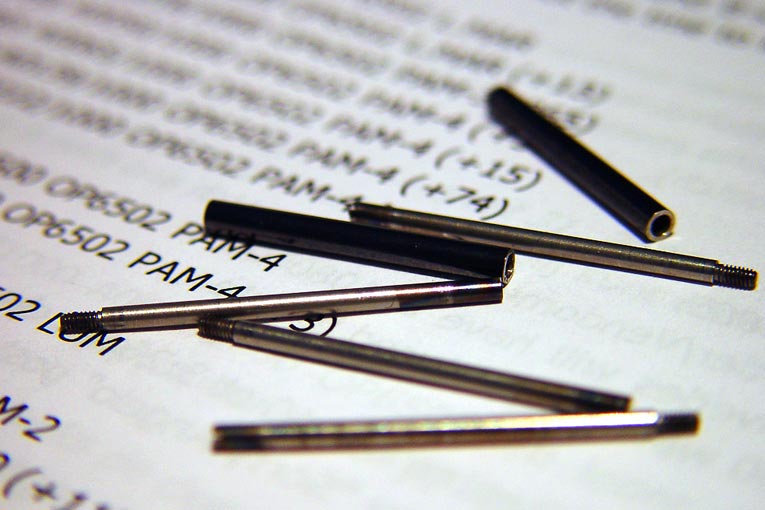
[ picture #08: Pre-A screws
and tubes. ]
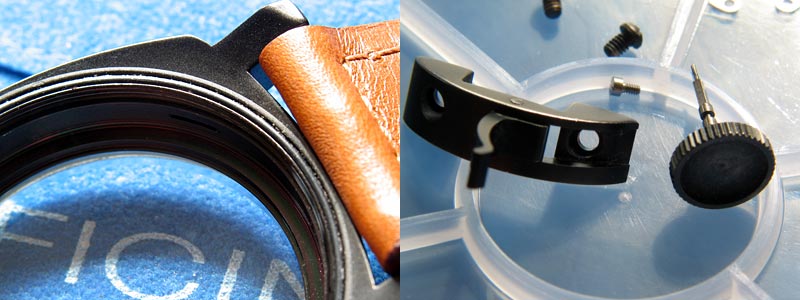
[ picture #09: Empty case. ]
The Curse of the White Dial.
For a long time
it was
thought that no white dialed T SWISS MADE T OP 6500 pre-A's had been
made, but
then an OP 6500 pre-A PAM 003 surfaced in California in late 2004.
Because
these are so rare, when this watch emerged, it was thought that it was
a
prototype. Or a test watch, even though it had no shadow case. Thus far
I have
not seen an OP 6500 PAM 010 Luminor, a watch that given the above find,
logically should exist too.
Of all pre-A
watches, those
with white T SWISS MADE T dials command the lowest prices. Surely not
having a
T-SWISS-T dial is the main cause of that. Not having this pre-Vendome
style
dial, there are no directly visible differences between a pre-A PAM 003
and a
regular A or B-series T SWISS MADE T dialed PAM 003. That said, the
pre-A
straps and sewn-in buckles -all in good condition- are collectors'
items in
their own right. So that is a premium over a regular A- or B-series
white
dialed watch. You can further add some extra value for the old style
boxes and
for the joy and exclusivity of having a real pre-A.
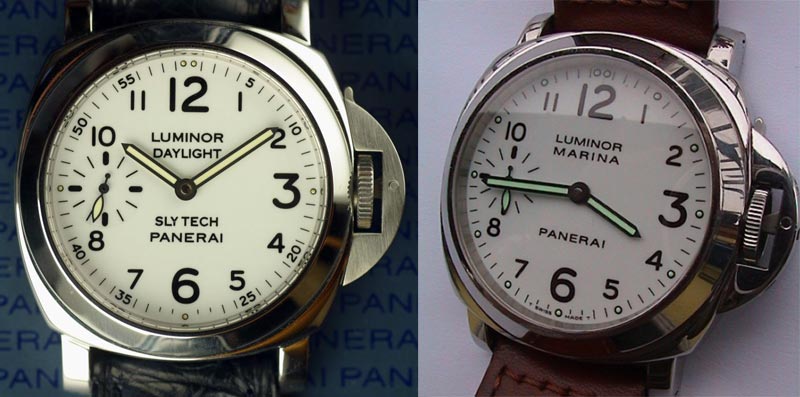
[ picture #10: White dial
pre-A next to a pre-Vendome Daylight � different dial lay-out. Picture
by Hiro-san and Markus Tschopp.]
Enter the Pre-A Mare
Nostrum.
Somewhere in
between those
1000 watches came a little less than 400 OP 6501 42 millimeter PAM 006,
007 and
008 Mare Nostrum chronograph watches. When Vendome took-over, 398 Mare
Nostrum
had been lying unsold in the vaults of the old company. These were
altered and
re-sold as the Vendome Mare Nostrum and were given a new dial, a new
bezel, a
new case back and a new strap and buckle. They came, however, in the
original
pre-Vendome mahogany, and later burl wood box.
I believe Mare
Nostrums
should be considered pre-A too which, by the way, makes life a lot
easier. Like
its pre-A Luminor and Luminor Marina sisters, the Vendome Mare Nostrum
has a
T-SWISS-T dial. Unlike the 44 pre-A's, however, this specific dial does
not at
all resemble the pre-Vendome 5218-301/A Mare Nostrum dial. The Vendome
dial
lay-out is completely different from the older, slate blue design and
came in
three colours. The blue dialed PAM 006, the white dialed PAM 007 and
the black
dialed PAM 008, produced only in 1997.
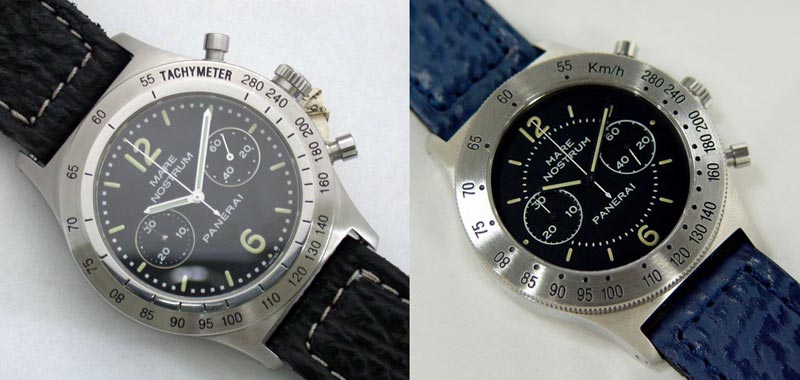
[ picture #11: Vendome Mare
Nostrum T-SWISS-T next to pre-Vendome 5218-301/A. Picture by William
Loi. ]
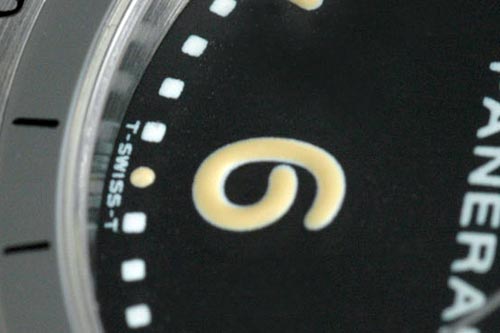
[ picture #12: Close-up of
T-SWISS-T. Picture by Nick. ]
For the Mare
Nostrum the
adventure stopped after these 398 watches. My guess is that they were
hard to
sell. As late as 2003 it was still possible to find a new in box
pre-Vendome
Mare Nostrum at the Bottega d'Arte Panerai Boutique in Firenze. Even
though
hard to sell at the time, there are persistent rumours that a Mare
Nostrum
style chronograph is about to re-appear in the coming years. The fact
that a
pre-Vendome 5218-302/A Slytech Mare Nostrum is pictured prominently in
Officine
Panerai's 2005 catalogue may well be a precursor of its upcoming
rebirth,
though it might just as well be that is was put forward to create a
historical
back-drop for the new Slytech-series of large chronographs. No matter
what will
happen, there has been a steady rise in the popularity of both the
pre-Vendome
and Vendome Mare Nostrum these days.
The Pre-A OP 6502 Series.
After the last
Vendome Mare
Nostrum, the millesimation numbering of the first series of 1000
Luminors and
Luminor Marinas was picked-up again where it was left-off. But this
time with
the OP 6502 case reference. For this reason it should be considered the
third
series of pre-A watches. Even though the numbering within the series is
a
continuation of the first pre-A batch.
It is as yet
unclear where
the exact cut-off points caused by the insertion of the Mare Nostrums
are
located. Most Vendome Mare Nostrums are somewhere in between serial
numbers BB
970550 and BB 970950. For 44 millimeter watches, the highest OP 6500
pre-A I
have seen, the unique white dialed PAM 003, is numbered BB 970509. The
oldest
OP 6502 pre-A I know of is a PAM 002 numbered BB 970950.
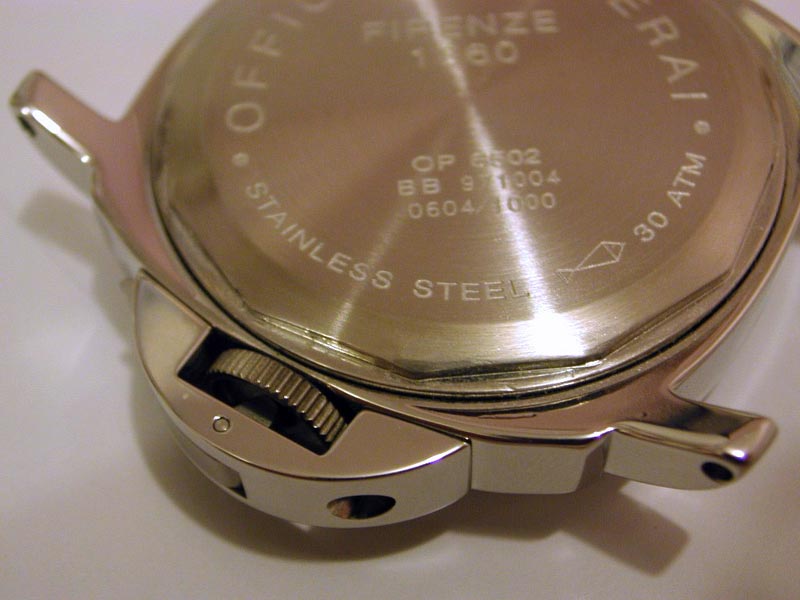
[ picture #13: Example of an
OP 6502 case back. ]
For OP 6502
pre-A watches of
the second batch of the first series, the last four digits of the
BB-number or
serial number minus 400 (for the Mare Nostrums), should equal the four
digits
of the millesimation number. Format: BB 97XXXX � 400 = YYYY/1000.
EG: OP 6502 �
BB971000 =
0600/1000 or OP 6502 � BB971294 = 0894/1000.
Again, the
relationship
between serial number and millesimation number is always consistent and
logical. It is extremely funny seeing watch dealers in their ads
blanking-out
the millesimation but omitting to do so for the serial number. Do the
math and
send them an email saying: "I see that 0600/1000 is for sale" and most
of the time they reply back: "Ah, obviously you know my watch. Can you
tell me some of its history?"
The Second Pre-A OP 6502
Series; Pre-A's with Prefix "A".
Immediately
after the 1000
Historical collection Luminors and Luminor Marinas, and well after the
400 numbers
reserved for the Mare Nostrums, around serial number BB 971400, a
second series
of Luminors and Luminor Marinas saw the light of day. Again, in total,
1000 OP
6502 PAM 001, 002, 003, 004, 009 and 010 were planned, but this time
only about
300 watches were actually made.
Further
production was
probably stopped because the regular A-series Historical line, with the
new T
SWISS T dial lay-out, was ripe for distribution. Or maybe Officine
Panerai
laid-off the pre-A series because the old-style dial was almost
finished and
they wanted to keep some T-SWISS-T's as spares, one never knows with
Italian
companies? Even today, if you are really lucky, an Officine Panerai
Service
Center might on request install a T-SWISS-T dial in your PAM 040, or in
an old
PAM 004 or 009. I have seen it happen several times.
Dirk Grandry,
the well known
Belgian Officine Panerai historian/Guru, observed in March of 2003:
"You
need to know that in real production, there's no real time gap between
the
productions of watches with different suffixes. When they reached 1000,
Angelo
probably opened a bottle of spumante at the production plant, chatting
with the
workers for half an hour or so. After that pause, they added the
A-suffix and
continued production. They probably forgot to ask Angelo how many he
was
planning to sell of the Marinas. It's also possible that the spumante
had
blurred their minds, taking a wrong "Luminor" case back. It's also
possible that Angelo didn't have the time to talk with Franco Cologni
regarding
product & marketing strategies at that particular moment in
time...."
The second
series of a 1000
watches (or to be more specific 300) is known as the pre-A series WITH
prefix
"A". Is this contradictory? Not at all, see the above comments by
Dirk Grandry. While these watches do have prefix "A", they definitely
are pre-A models. They can easily be distinguished from regular
A-series models
by their serial number. Again, there is a consistent logic between the
BB-number and the millesimation number.
For all Luminor
Marinas
within this batch (PAM 001, 003 and 004) it is even easier to tell. The
millesimation format for pre-A here is A0XXX/1000, where for A-series
Luminor
Marinas the format should read AXXXX/1500. This is the reason why it is
possible to have a PAM 001 Luminor Marina with an A-prefixed
millesimation of a
1000 pieces. In the regular A-series ONLY Luminors (bases) have a
millesimation
limited to 1000, while of the Luminor Marina A-series, 1500 were made.
Likewise, an "A" prefixed Luminor with a matriculation number higher
than 300 cannot be a pre-A watch.
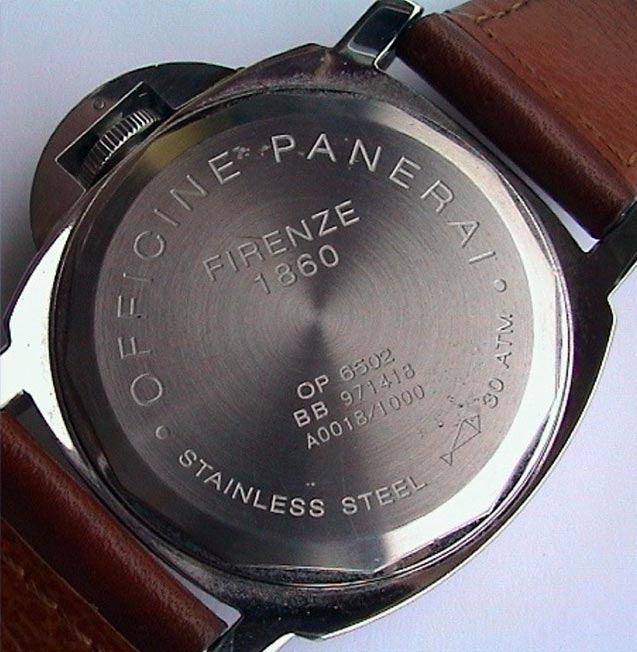
[ picture #14: Example of an
OP 6502 case back with prefix "A". ]
For pre-A OP
6502 watches
with prefix "A", the last four digits of the BB-number or serial
number minus 1400, should equal the four digits of the millesimation
number.
Format: BB 97XXXX � 1400 = A0YYY/1000.
EG: OP 6502 �
BB971401 =
A0001/1000 or OP 6502 � BB971621 = A0221/1000.
More numbers for the WIS.
All in all,
there are two
ways of checking whether a watch is genuine pre-A.
1) The
relationship between
serial number (BB) and millesimation number (/1000) should be
consistent and
logical.
For OP 6500
watches, the
last 4 digits of the BB-number or serial number should equal the 4
digits of
the millesimation number.
OP 6501 watches
are always
considered pre-A.
For OP 6502 pre-A watches of
the second batch of the first series, the last 4 digits of the
BB-number or
serial number minus 400, should equal the 4 digits of the millesimation
number.
For OP 6502 pre-A watches
with prefix "A", the last 4 digits of the BB-number or serial number
minus 1400, should equal the 4 digits of the millesimation number.
2) Assuming that
no more
than 1300 pre-A Luminor and Luminor Marinas were made, ANY Officine
Panerai
watch with a serial number lower than BB 971700 is a pre-A watch.
1000 total OP
6500 Luminor
and Luminor Marina (PAM 001, 002, 003, 004, 009 and 010) 0XXX/1000 and
OP 6502
(PAM 001, 002, 003, 004, 009 and 010) AXXXX/1000, and
400 total OP 6501 Mare
Nostrum (PAM 006, 007 and 008), and
less than 300 total OP 6502
Luminor and Luminor Marina (PAM 001, 002, 003, 004, 009 and 010)
A0XXX/1000
Total: 1000 +
400 + max. 300
= max. 1700 pre-A watches including the Mare Nostrum.
How many of
each? Luminor,
Luminor Marina, PVD, white dial? No one really knows�
Oddball Pre-A and T-SWISS-T
Watches.
I have seen
several PAM 040
Titanium Luminor Marinas with T-SWISS-T dials installed, probably this
was done
at the factory during the original production run. However, I have also
seen a
few PAM 040's that had their T SWISS T dials, or even an L SWISS L dial
replaced by a T-SWISS-T dial when at an Officine Panerai Service
Center. I have
seen the same thing happening to some PAM 004's and PAM 001's from the
regular
A-series.
As long as this
was done by
Officine Panerai, I see no problem in this. But we must not forget that
these
watches are not pre-A. I also learned that for some watches (like the
first
half of the production run of PAM 040), the Officine Panerai spare part
code
for a replacement dial could either mean T-SWISS-T or T SWISS T. No
distinction
is made in the stock list.
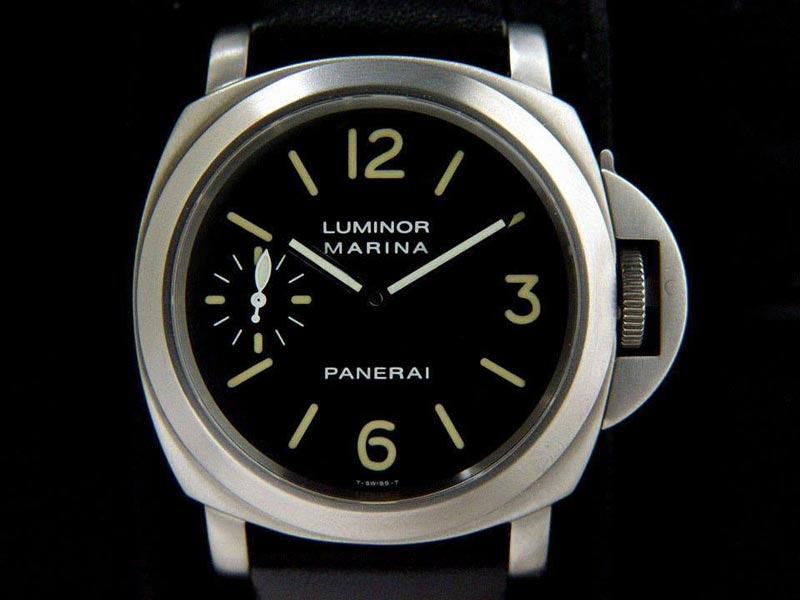
[ picture #15: PAM 040
T-SWISS-T. Picture by Gary Dees. ]
There are even a
few
B-series watches known to exist with T-SWISS-T dials. On Piero
Lapiana's Club
Panerai site, a B-series Luminor Marina is registered (#395) with a
T-SWISS-T
dial that has a black small seconds hand and the pre-A style Geneva
striped
movement. A purist's mess for sure, but an intriguing one.
In November of
2003, at
PDay#2 in Cologne, Angelo Bonati presented an orange dialed T-SWISST-T
Luminor
that was housed in a pre-Vendome 5218-210 PVD case. This older
prototype
suddenly emerged from his inside pocket, at the same time when he
presented the
factory drawings for PAM 195 for the first time on the European
mainland.
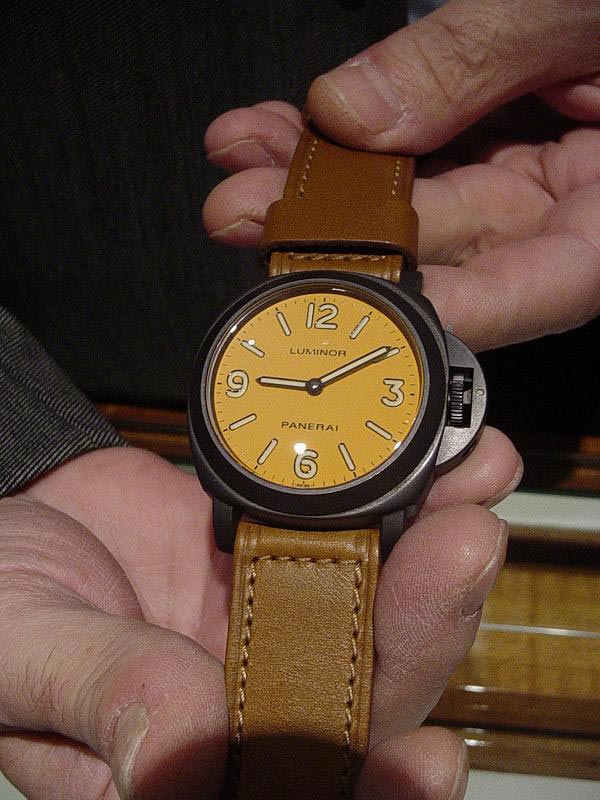
[ picture #16: T-SWISS-T
orange dialed 5218-210 prototype. Picture by Volker Wiegmann. ]
In 2003, in
Bergamo in
Italy, an OP 6500 pre-A was sold that had a 5218-201/A Logo dial. When
asked,
the owner stated that this watch was sold to him as is. He even offered
a
prospective buyer to join him on a trip to Milan where the watch was
bought.
The jeweller who originally sold the watch was prepared to testify in
writing
that he got this watch from the factory with the Logo dial.
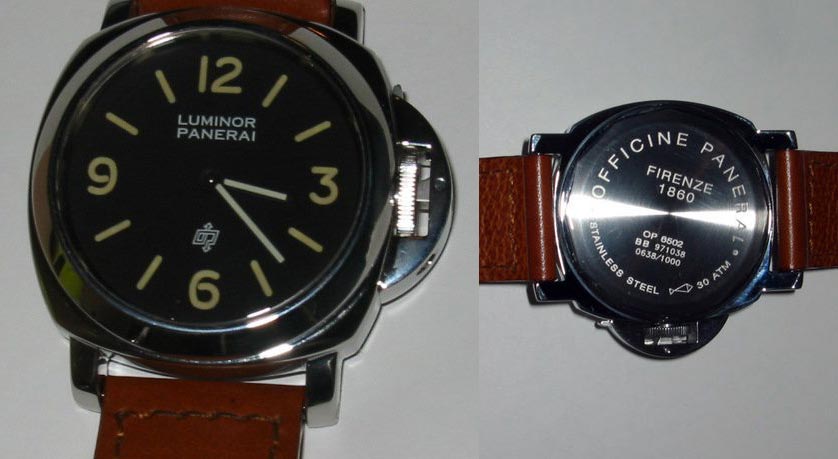
[ picture #17: OP 6500 pre-A
with a Logo dial. ]
A friend of mine
(or rather
several friends, each in turns) has owned a Titanium shadow OP 6535
cased
(probably) pre-C series PAM 055 with an almost matte brown coloured
T-SWISS-T
Base dial installed. This watch was bought directly from a very senior
Dutch
Richemont employee who got it from someone at the factory in Neuch�tel
in
Switzerland. The story goes that this specific watch was a prototype
for the
C-series brown dialed Titanium PAM's. The dial appears to have a wafer
thin
layer superimposed upon a black T-SWISS-T dial. All paperwork is
original and
stamped Officine Panerai Milano. This watch still lives in The
Netherlands and
as soon as I can take pictures of it, I will add these here.
The Pre-A Movement.
From the Otto
Frei website:
[A�] 16.5 ligne pocket watch movement, 17 jewels, Incabloc shock
protection,
subsidiary seconds and at 6 o'clock. Hand sizes are 115/200/28. Because
of its
size, this is a comfortable movement for the beginning watchmaker (and
for copycats!
[MB]). Pocket watches have the crown at 12 and small seconds at 6.
Wrist
watches have the crown at 3, so all you do is turn the dial location
1/4 and
wow! You now have a large wristwatch with small seconds at 9. ETA owns
the
Unitas name and have made the Unitas movements for almost thirty years.
All
Unitas movements these days are being stamped ETA 6498.
The booklet that
comes with
a pre-A Luminor Marina shows a picture of the ETA 6497 movement with
Rhodium-plated 'soign�'-finish and the text: "All movements used in the
Luminor Marina model produced from November 1997 have the Chronometer
Certificate by the Controle Suisse des Chronom�tres".
The pre-Vendome
Officine
Panerai movements run at the standard ETA 6497's 18,800 beats. It is
unclear
whether pre-A movements were already beefed-up to 21,600 beats. In one
of his
many sleep deprived moments, Dirk held a pre-Vendome 5218-203/A to one
ear, and
the pre-A PAM 001 to the other. The PAM 001 appeared to tick faster
�his guess
was that these were already 21,600 beat movements. The pre-A booklet
further
states that there is a 40-hour power reserve.
The red numbers
in the
picture below indicate the main differences between the movements:
Pre-A movements are
personalised "Officine Panerai Firenze"
Pre-A movements are
indivually numbered
"seventeen (17)
jewels" written in full
Orientation of
decoration is
45 degrees rather than from top to bottom
"17 jewels" and
"swiss made" grouped
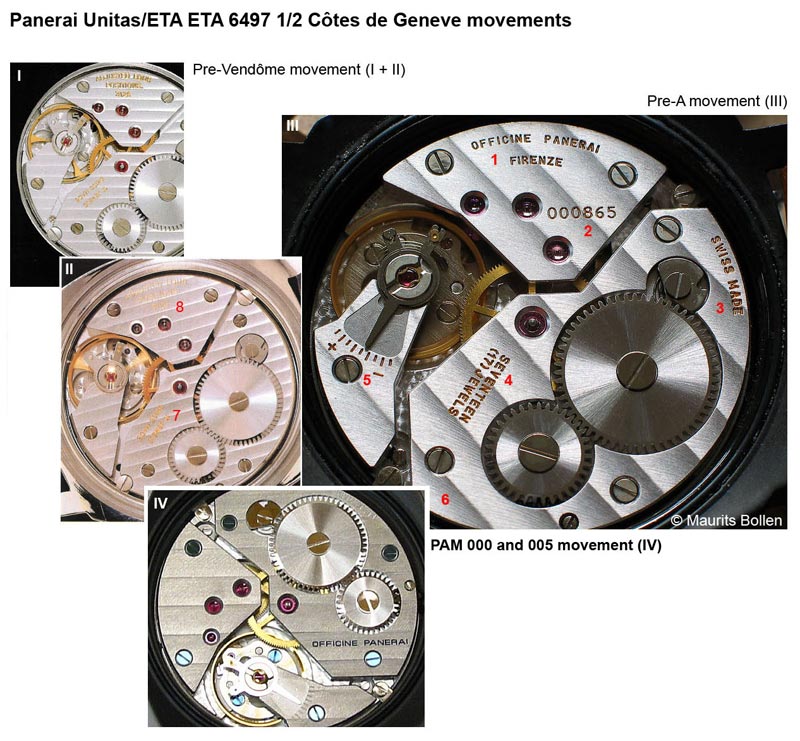
[ picture #18: Pre-Vendome,
pre-A and other Geneva striped movements. ]
The movement
used in the PAM
000 and 005 nouveau logo series is also included in the picture. Here
you can
see that this movement is less refined than the pre-A and pre-Vendome
movements, and surely less refined than the A-, B-, C- and D-series OP
I and OP
II movements, or the D- through G-series OP X and XI movements. These
were
personalised even further and technically more improved. Hence the
lower price
of the PAM 000 and 005.
In the new
H-series, you
will see the re-introduction of the Cotes de Gen�ve movement decoration
for all
Officine Panerai Historic series. I like that.
T-SWISS-T Dials compared to
Pre-Vendome Dials.
Some say that
T-SWISST-T
dials are recycled, left-over original unfinished pre-Vendome dials.
Others say
they were simply ordered from the old dial supplier because the new
dial style
was not yet fit for production. According to the French Officine
Panerai
collector Yves Odier, the T-SWISS-T dials were ordered by "Vendome...
the
dials "and or un-finished dials from that supplier" were modified and
or re-ordered by Vendome, no T-SWISS-T dials were passed or handed over
from
Officine Panerai Firenze to Vendome."
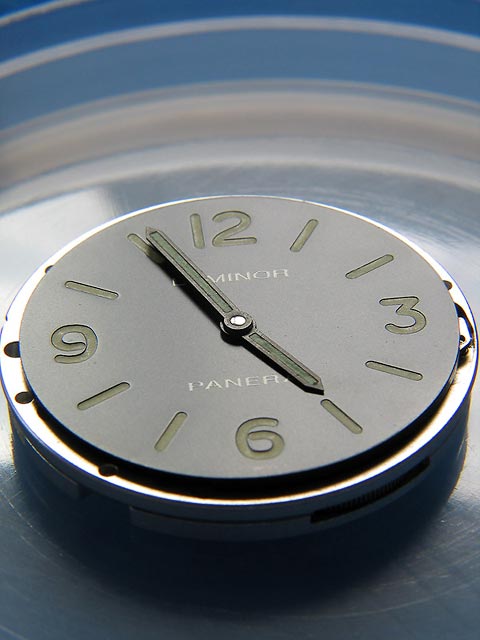
[ picture #19: Naked pre-A
T-SWISS-T dial. ]
For the pre-A
series these
pre-Vendome style dials were then printed with the new Vendome
typography. A
curve-legged "R" and an "E" with three horizontal lines of
equal length. Officine Panerai also added T-SWISS-T below the "6",
pre-Vendome watches have no text there. On almost all later watches
from the
Historical collection you will find the regular T SWISS T Tritium dial,
or
�from halfway the B-series- L SWISS L Luminova dials.
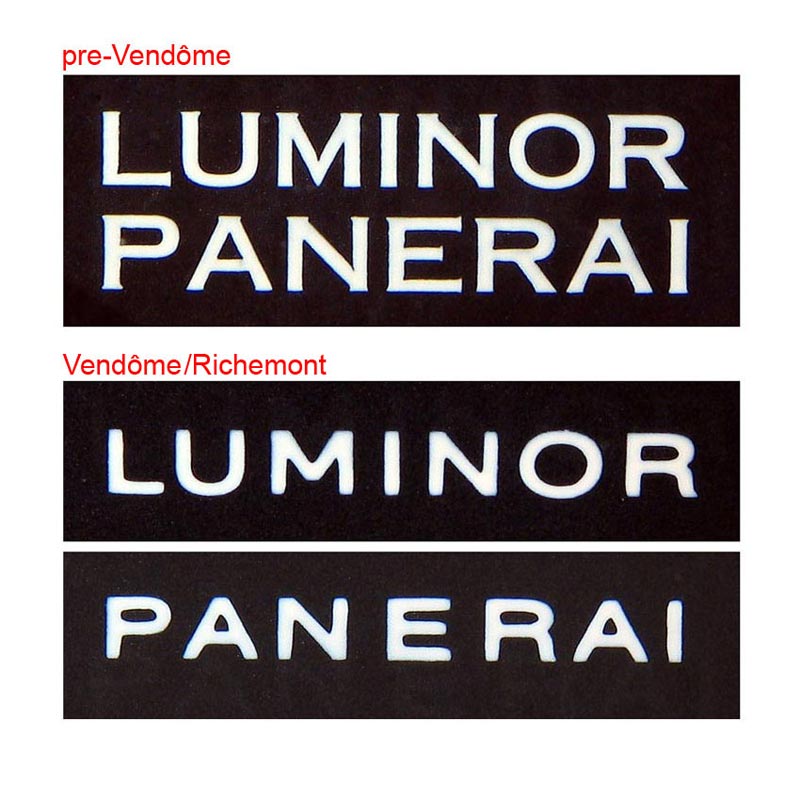
[ picture #20: Pre-Vendome
dial font compared to Vendome dial font. Look at the "E's" and
"R's" and the serif type letters on the pre-Vendomes ]
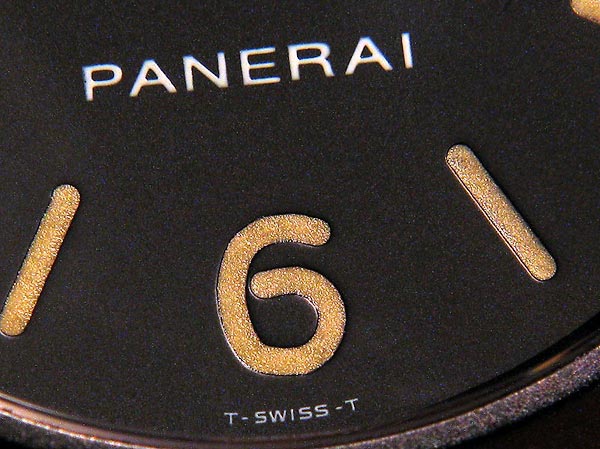
[ picture #21: Close-up of
T-SWISS-T. ]
Pre-A Panerai
with the
pre-Vendome style T-SWISS-T dials can be seen on the inside pages and
on the
cover of the 1997 Officine Panerai book by Giampiero Negretti "Orologi
da
Polso", or the international version "Legendary Watches". Some
good colour pictures can be seen in the 1999 Officine Panerai book
"Panerai Historia: Nel Profondo del Mare" or "From the Depths of
the Sea". They are pictured in the 1998, four page Officine Panerai
Storici leaflets and can be found in official advertisements as late as
1999.
Even in Officine Panerai's 2002 catalogue a pre-A PAM 002 can be seen,
mistakenly identified as a PAM 112.
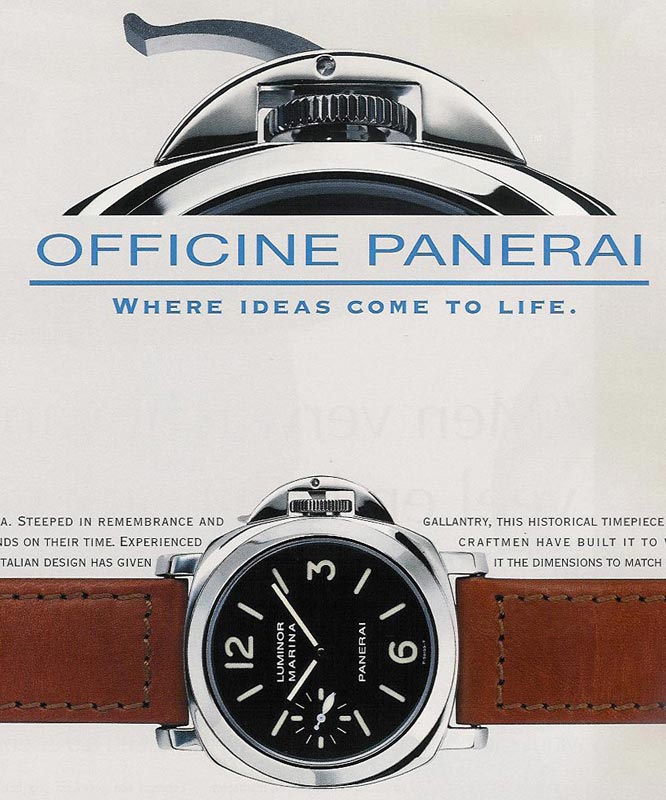
[ picture #22: Ad from
Jewels and Watches 1999. ]
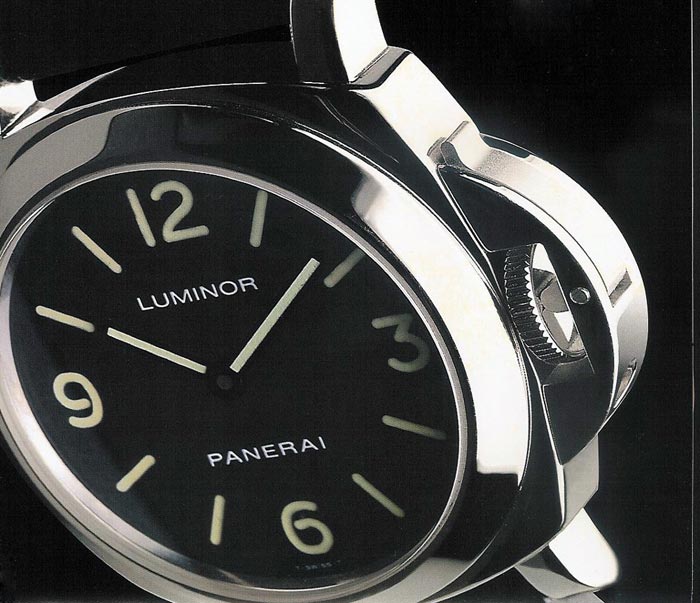
[ picture #23: PAM 112 in
2002 catalogue. ]
With a lot of
teaching from
Dirk Grandry, I have come to the conclusion that T-SWISS-T dials and
pre-Vendome dials are the same, they differ only in the way they were
finished.
T-SWISS-T
indices most of
the time look less "fat" or less wide than their pre-Vendome
brethren. I believe this has two reasons. First, the recessed area of
the
indices on T-SWISS-T dials is not varnish filled to the level of the
dial, it
is filled only with Tritium (maybe there is an ever so slight layer of
varnish
as a finisher).
At the same
time, the index
cavities on T-SWISS-T dials are filled-up with Tritium to a higher
level than
was done in the pre-Vendome era. Pre-Vendome indices appear to be
substantially
deeper. Thus, the magnifying effect of the thick pre-Vendome layer of
varnish
is not present in a T-SWISS-T dial. This layer covers the complete dial
on
early pre-Vendome watches and it is what makes these dials so very
special, it
creates depth in the dial.
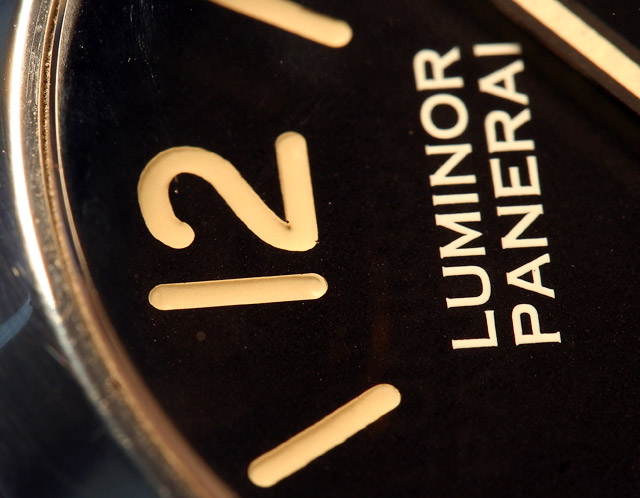
[ picture #24: Pre-Vendome
5218-201/A dial. Observe the painted vertical edges. Recesses fully
filled with
varnish. ]
Second, I
believe on early
pre-Vendomes the vertical sides of the recessed area are covered with
Tritium
too. On T-SWISS-T dials, only the horizontal, flat area is painted with
luminous material. Albeit to a higher level. This contributes highly to
the T-SWISS-T
indices appearing less wide. From what I have seen, only the early
pre-Vendomes
have the vertical edges painted. That is why I like 5218-201/A, 202/A
and 203/A
more than the later Slytechs. Slytech dials are a lot more like
T-SWISS-T
dials. This except for prototype Slytechs like Hammer's 5218-201/A
Slytech
Submersible. It is likely that re-printed 5218-203/A dials were used
for the
prototype Slytechs. Later pre-Vendomes also miss the full layer of
varnish.
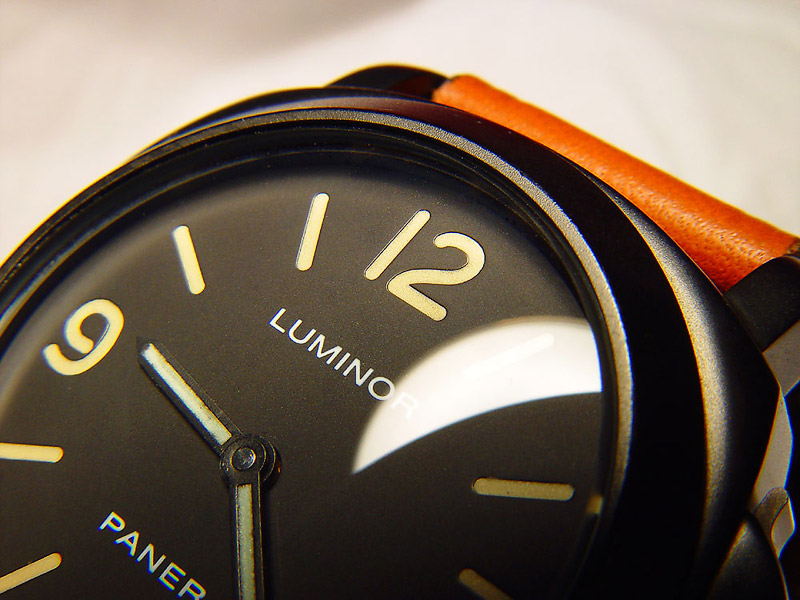
[ picture #25: The T-SWISS-T
dial in full glory, my (ex) pre-A PAM 009. ]
Some more
pictures to
illustrate the text:
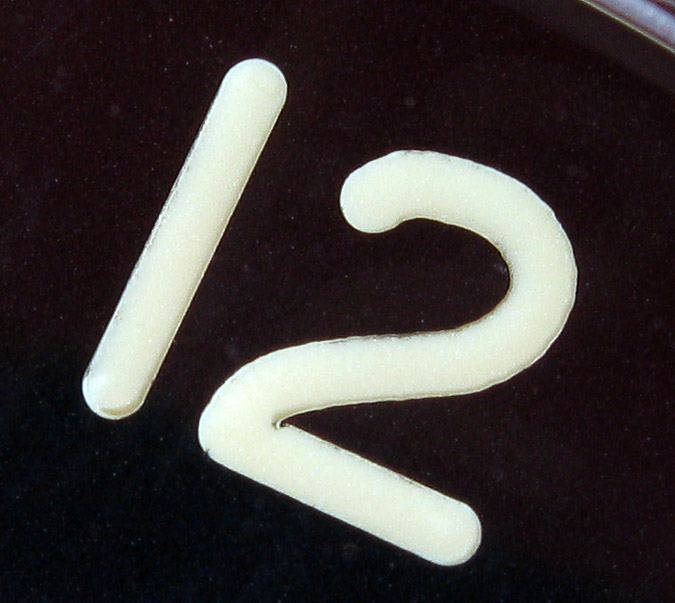
[ picture #26: Pre-Vendome
"12" index. The vertical edges of the index are covered in Tritium
too, the whole index is varnish filled. ]
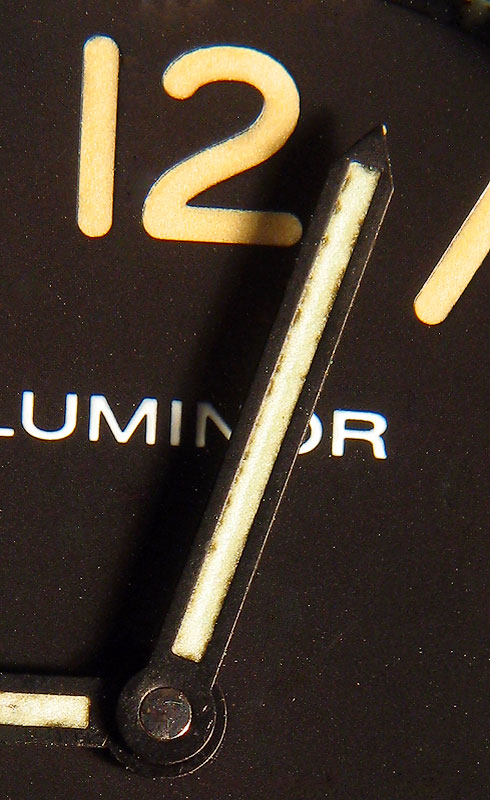
[ picture #27: Pre-A
"12" index. The vertical edges are unpainted, no varnish. The Tritium
is filled to a higher level, indices appear less wide. ]
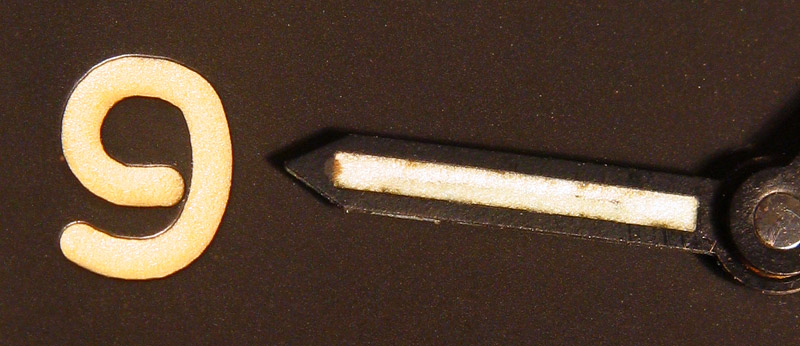
[ picture #28: Pre-A
"9" index. Obviously from a pre-A PAM 002 or 009. ]
On almost all
later
Historical watches you will find the regular T SWISS T dial, or L SWISS
L. On
these dials, the Tritium material filled the recesses to a much higher
level,
almost reaching an even plane with the dial. A thin gap between dial
edge and
Tritium acts as a border to visually separate dial and luminous
material. This
substantially differs from contemporary series A-watches like PAM 027
and 029,
where the Tritium was applied onto the dial, like a sausage.
This later style
of Tritium
filling can nevertheless be found on some Historicals too. Dirk Grandry
had a
talk about this with Mr. R�ssner during the Cologne meet in 2002, as he
had
noticed that there was a lot of variation in the dials of watches of
the
Historic collection. On some watches, the luminous coating was more
sunken, and
you can clearly see the edges of the indices. Mr. R�ssner confirmed
this to
Dirk, and told him he always selected a watch with more sunken markers
for his
personal use or for his friends.
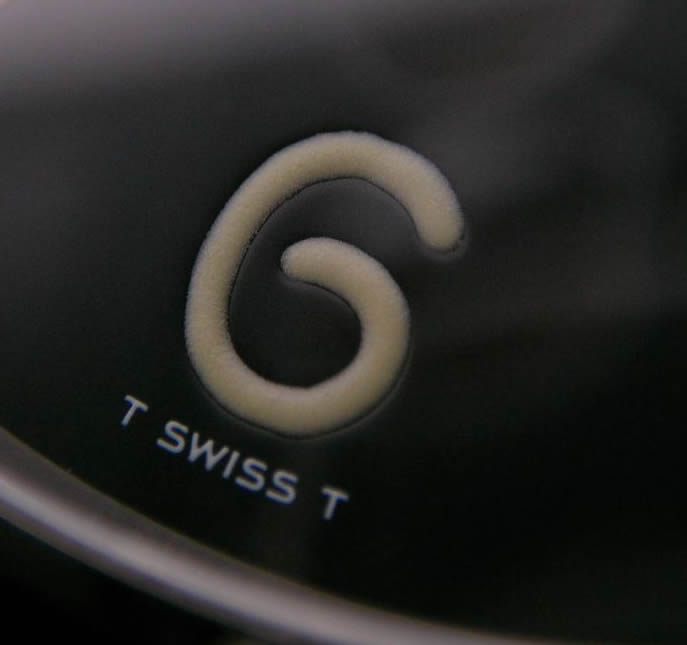
[ picture #29: Regular
A-series "6". The Tritium is almost level with the dial surface, yet
the edges remain visible. Picture by Hiro-san). ]
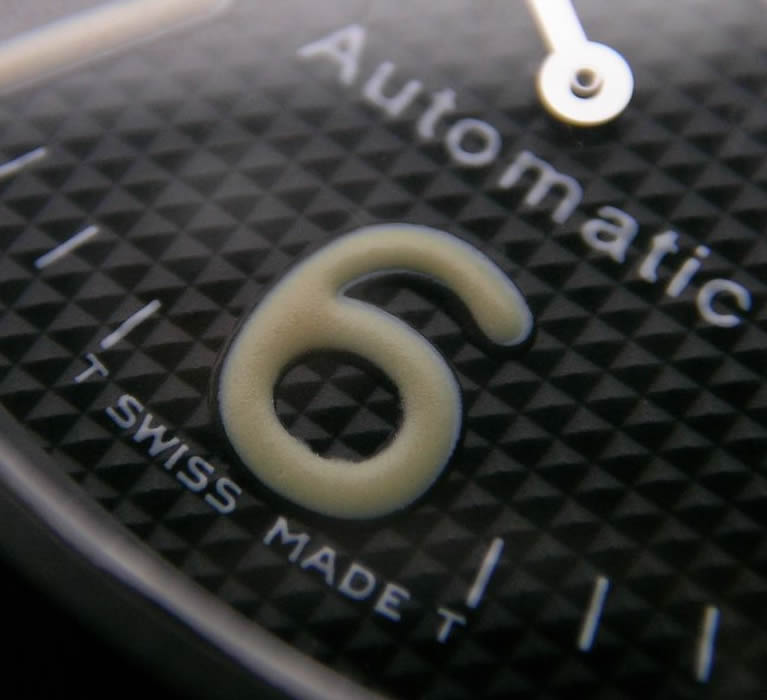
[ picture #30: Sausage-like
"6" on an early Power reserve. The Tritium was applied onto a printed
index on the dial rather than in a recessed cavity. Picture by
Hiro-san). ]
A much heard
mistake is that
early (pre-Vendome, pre-A) dials are called "sandwich dials". They
are NOT. Prior to PAM 127 and the 1995 Historicals and some Radiomirs
for sale
now, only vintage Officine Panerai had real sandwich dials, where the
luminous
material was applied onto a separate disk under the actual dial and
visible
through cut-out numerals filled with varnish.
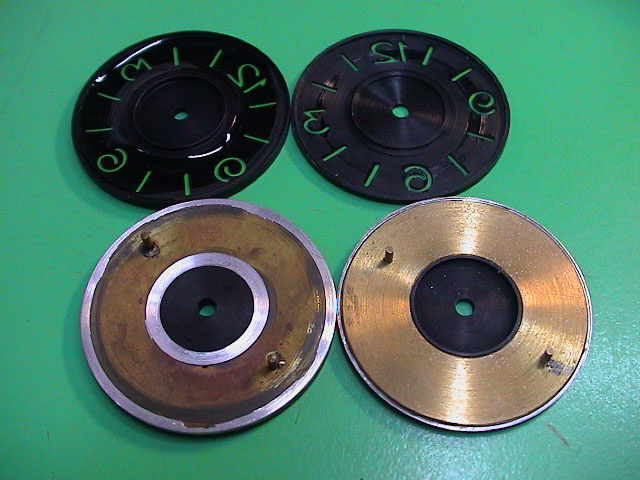
[ picture #31: Vintage
sandwich dials. Note the separate disks... Picture by Volker Wiegmann.]
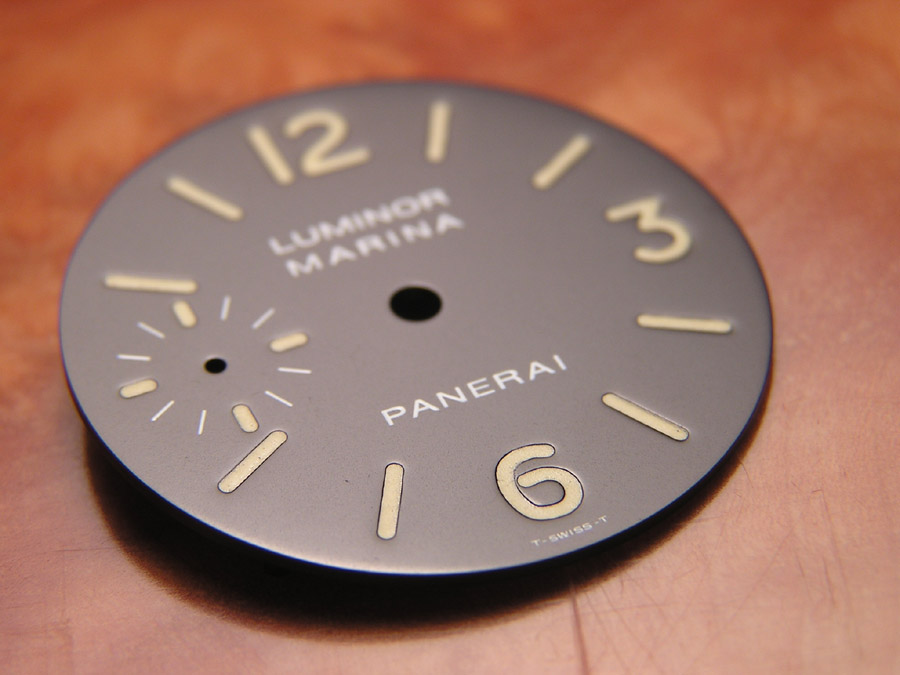
[ picture #32: Pre-A 004 or
001 T-SWISS-T dial. No dual disks! Picture by Volker Wiegmann. ]
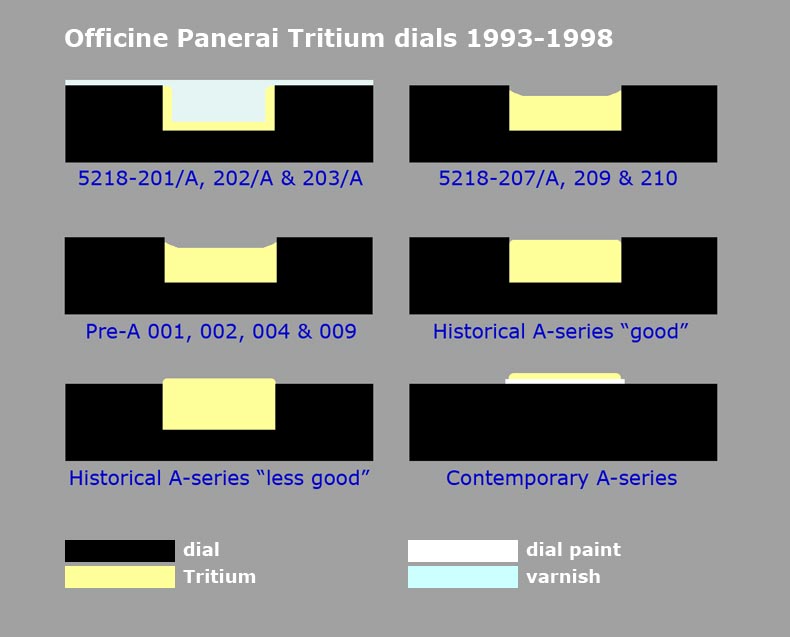
[ picture #33: Drawing of
several Tritium dials, based on Volker Wiegmann's chart. ]
Pre-A Straps and Buckles.
One of the
unique
characteristics of the pre-A series is that they have a strap and
buckle design
that no other Officine Panerai watch has, be it pre-Vendome or from
later
Vendome series. All pre-A's came with two straps, made by Hirsch in
Austria.
These straps are, design wise, generally equal to later A-series
Vendome calf
straps. This, however, with the restriction that the pre-A buckles were
sewn-in. The underside of the pre-A strap is of a darker colour than
the straps
we see today and is stamped "Officine Panerai", "C" and
sometimes "Made in Austria". Pre-A straps were marginally longer than
today's straps, 115/85 millimeters opposed to 115/75 millimeters.
As a rule of
thumb, black
dialed stainless steel and PVD Luminor Marina pre-A's came with a
tapered 24
millimeter tan strap and with a black rubberised calf strap. All on
polished
stainless steel or PVD 22 millimeter buckles. Stainless steel and PVD
Luminor
pre-A's, as well as most white dials, came with a black calf strap (the
underside was black too) and also with the same rubberised black strap
as
mentioned above. The buckles were 22 millimeter PVD items or 22
millimeter
polished stainless steel. The Mare Nostrum series were sold with a
straight 22
millimeter crocodile strap on a brushed 22 millimeter buckle.
Variations on all
themes are possible, of course. Except that, at that time, no crocodile
straps
were made for the 44 millimeter cases.
The design of
the pre-A
buckle is the same for all pre-A watches. It is basically a 22
millimeter
miniature version of the big 24 millimeter pre-Vendome buckle without
the logo,
that was either available in polished stainless steel, matte
pencil-lead grey
PVD or brushed stainless steel. The buckle is, however, more curved to
fit the
wrist than its older sister and it is stamped "PANERAI", which is
offset to the right. This type of buckle was revived for PAM 127 "1950"
and now too for the 2005 Historical collection (both of the screw-in
type).
The problem is
that, after
the pre-A run, these straps and buckles were available for a very short
time
only. A few A-series watches can be found with pre-A straps and
buckles. This
may have happened, however, at the watch dealer where these watches
were
originally bought. After that, anyone who needed a replacement strap
for a
pre-A either had to have a strap custom made and the original buckle
sewn-in,
or revert to a strap from the regular A-series. This, of course, meant
abandoning the original buckle and opt for the 22 millimeter thumbnail
tang
buckle. All the above are reasons why it is extremely difficult to find
good
pre-A straps and buckles. When included in your pre-A set, the original
straps
and buckles surely are worth a considerable premium.
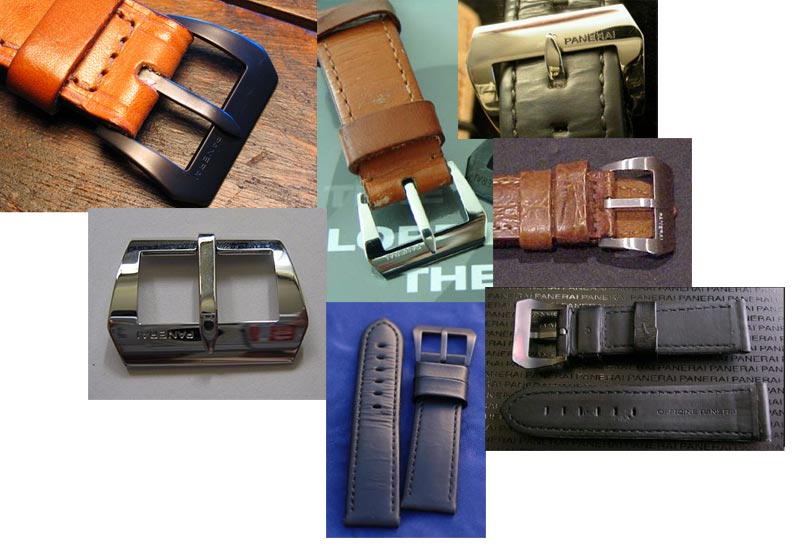
[ picture #34: Pre-A Buckles
and straps. ]
Pre-A Boxes and Papers.
Pre-A paperwork
consolidated
the current Libretto di Garanzia warranty booklet and instruction
manual into
one booklet. This booklet has the original owners' tear-out
registration card
and a cut-out to hold the stamped warranty card. The booklet was kept
secure in
a white cardboard folder that was sealed with a sticker that had the
serial
number, movement number (matching to COSC certificate, if applicable)
and watch
description.
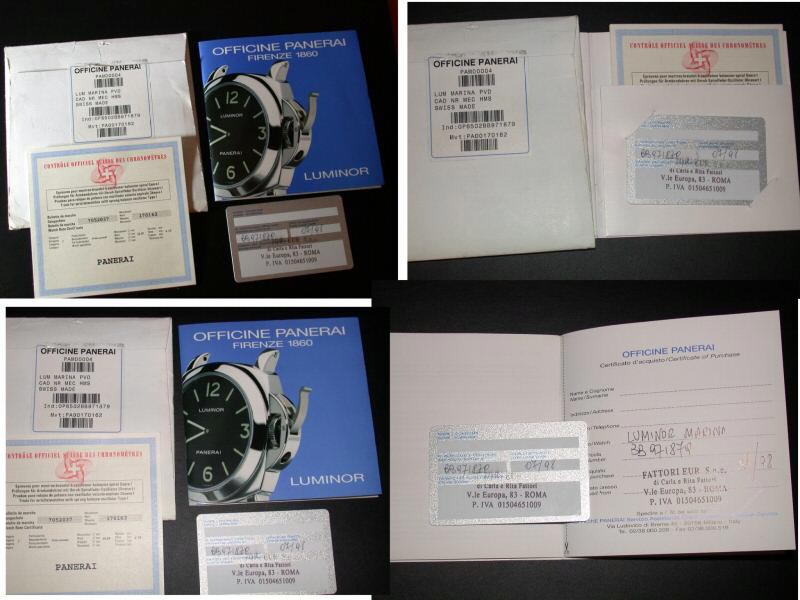
[ picture #35: Even though
from a very early A-series T-SWISS-T watch, the paperwork is exactly
like it
came with pre-A's. Picture by O.J. Whatley. ]
The dark
cardboard box that
housed pre-A's was of a shoe box type. Unlike today's outer boxes,
where the
lid is of equal height as the lower box, the lid of the pre-A box is
only an
inch in height. I have never seen the intermediate flat and cheap
looking
folding box together with a pre-A. The cherry wood inner box had a
darker
finish and was lower in height and shallower than the current cherry
wood box.
It is all a matter of millimeters, but again, having the right boxes
surely is
worth a premium. I have no idea what the outer shipping box looked
like, if at
all originally present in the pre-A package.
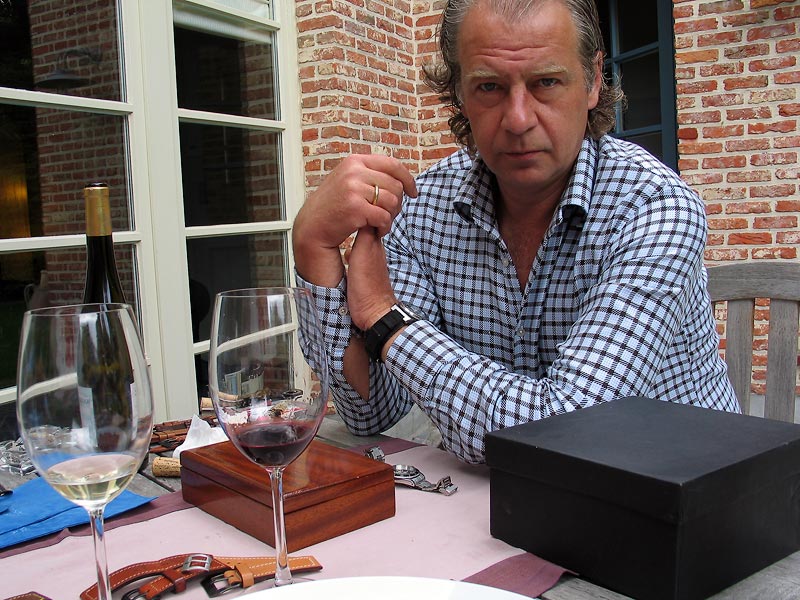
[ picture #36: Dirk's
terrace. On the right a pre-A shoe box. Is Dirk really wearing an
Offshore? ]
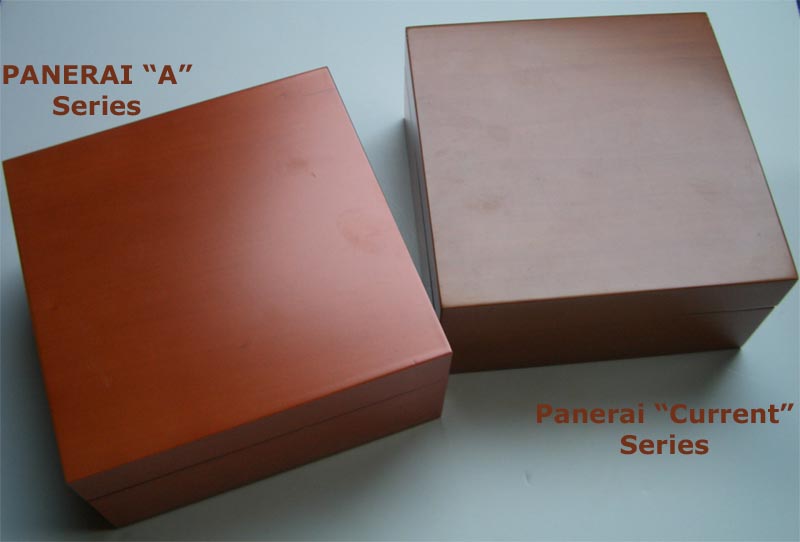
[ picture #37: Pre-A inner
box. Not accredited. ]
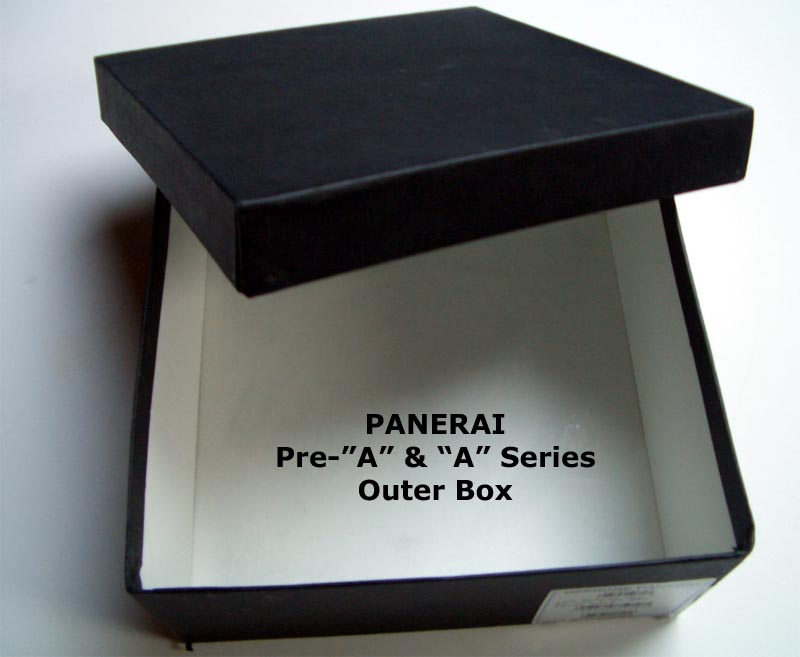
[ picture #38: Pre-A
shoe-box. Not accredited. ]
Acknowledgements.
A lot of
Paneristi and
friendly watch dealers have helped me over the years to gain knowledge
of pre-A
Officine Panerai watches. But non so as Dirk Grandry. Almost everything
I know,
I know either directly from Dirk, or from one of his literally hundreds
of
posts on the subject. Most of what is written here can be found on the
(old)
forum. I merely rewrote, combined, and sometimes completed the know-how
that is
out there on the forum. Nevertheless, a lot of it is theory and
sometimes even
outright speculation. I guess that is the reason why Dirk himself has
not yet
written an article on pre-Vendome and pre-A Officine Panerai watches.
Even
though I think he definitely should.
Any comments,
suggestions,
additions, accreditations, theories etc. etc. are welcome. If possible,
I will
include these in a follow-up article.
I also like to
thank some
fellow (ex) pre-A or T-SWISS-T owners, in some instances whom I have
corresponded and spoken with endlessly. Others have provided me with
valuable
info on the dials and the serial numbers of their watches. Hilton Leo
(Lurker),
Kirk Colvin, Joel Pirela, Bas Scheepstra, Clif Watkins, Stanley
Manuputty,
Volker Wiegmann, Jerrel Manbodh, Yves Odier, PJ (Mr. Yellow), Pegan Teo
and
Jeff and Valerie Meyer.
Special thanks
goes to Joel
Pirela, William Loi and Hiro-san for their great photography. Sometimes
their
pictures are better than actually having the watch in hand. All
pictures I used
in here are either my own, or taken from the public domain. I have not
asked
permission from the owners for any use in this article. Wherever I knew
the
owner, pictures are accredited accordingly. Good pictures can be found
on
Hiro-san's Panerai Carpe Diem website, http://www.ne.jp/asahi/panerai/carpediem/index.html.
Brush-up your Japanese first, though.
Many thanks to
Paneristi and
the current team of moderators who have weathered all storms and
returned this
fine site to a safe harbour where all willing to do so are welcome.
Special
thanks to Guy Verbist, of course.
MB